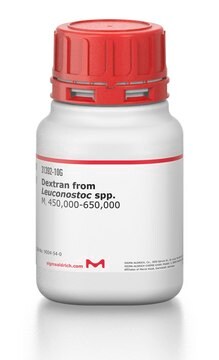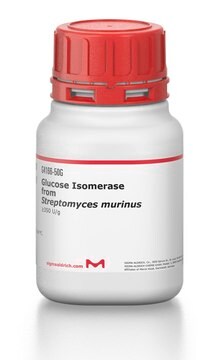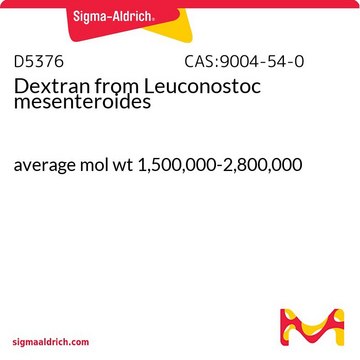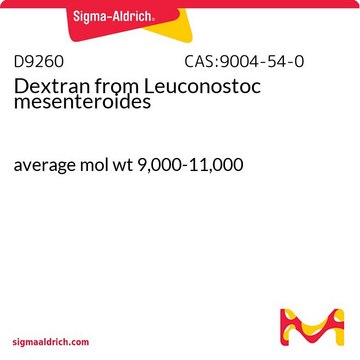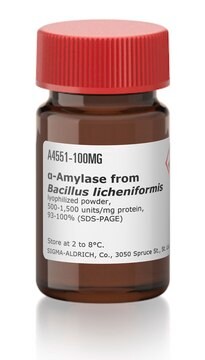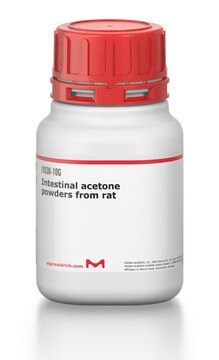Alle Fotos(2)
Wichtige Dokumente
D9909
Dextran Sucrase from Leuconostoc mesenteroides
lyophilized powder, ≥100 units/mg protein
Anmeldenzur Ansicht organisationsspezifischer und vertraglich vereinbarter Preise
Alle Fotos(2)
About This Item
CAS-Nummer:
MDL-Nummer:
UNSPSC-Code:
12352204
NACRES:
NA.54
Empfohlene Produkte
Biologische Quelle
bacterial (Leuconostoc mesenteroides)
Qualitätsniveau
Form
lyophilized powder
Spezifische Aktivität
≥100 units/mg protein
Zusammensetzung
Protein, ~15% Lowry
Löslichkeit
H2O: soluble 0.9-1.1 mg/mL, clear to slightly hazy, colorless to light yellow
Lagertemp.
−20°C
Allgemeine Beschreibung
Dextran Sucrase from Leuconostoc mesenteroides belongs to glycoside hydrolase family 70 (GH70). It functions through a retaining mechanism and uses two catalytic acidic residues. Dextran sucrase has a dextran binding site in the C-terminal domain.
Anwendung
Dextran Sucrase from Leuconostoc mesenteroides has been used:
- in immobilization on shirasu porous membrane (SPG) for dextran production
- in the enzymatic synthesis of dextran nanoparticles at various pH range
- in the immobilization with hydroxyapatite for dextran production
Dextran sucrase from Leuconostoc mesenteroides has been used in a study to investigate the functional and structural characterization of α-(1→2) branching sucrase derived from DSR-E glucansucrase. Dextran sucrase from Leuconostoc mesenteroides has also been used in a study to investigate the bioengineering of Leuconostoc mesenteroides glucansucrases.
The enzyme from Sigma has been used to prepare immobilized sphere for the production of dextran from sucrose.
Biochem./physiol. Wirkung
Dextransucrases are glucansucrases that are able to produce dextran, a glucose polymer linked mainly through α1-6 bonds. However, α1-3, α1-6, α1-4 and α1-2 bonds are also found, in both the main chain and the branching linkages. The peptide has approximately 1600 amino acids. The aspartic acid in position 551 is essential for catalytic activity, while glutamic acid 589 and aspartic acid 662 complement the catalytic triad. The activity of dextransucrase is decreased by EDTA, and is restored by the addition of calcium ions. Zinc, cadmium, lead, mercury and copper ions are inhibitory to various degrees.
Qualität
Chromatographically purified
Einheitendefinition
One unit will liberate 1.0 μmole of fructose per min at 37 °C, pH 5.4.
Physikalische Form
Lyophilized powder containing dextran, MES buffer salts and CaCl2
Lagerklassenschlüssel
11 - Combustible Solids
WGK
WGK 3
Flammpunkt (°F)
Not applicable
Flammpunkt (°C)
Not applicable
Persönliche Schutzausrüstung
Eyeshields, Gloves, type N95 (US)
Hier finden Sie alle aktuellen Versionen:
Besitzen Sie dieses Produkt bereits?
In der Dokumentenbibliothek finden Sie die Dokumentation zu den Produkten, die Sie kürzlich erworben haben.
Kunden haben sich ebenfalls angesehen
Sophie Bozonnet et al.
Journal of bacteriology, 184(20), 5753-5761 (2002-09-25)
A novel Leuconostoc mesenteroides NRRL B-1299 dextransucrase gene, dsrE, was isolated, sequenced, and cloned in Escherichia coli, and the recombinant enzyme was shown to be an original glucansucrase which catalyses the synthesis of alpha-1,6 and alpha-1,2 linkages. The nucleotide sequence
Seo Eun Chae et al.
Journal of microbiology and biotechnology, 19(12), 1644-1649 (2010-01-16)
This study investigates the buffering effects of calcium salts in kimchi on total acidity, microbial population, and dextransucrase activity. Calcium chloride or calcium carbonate was added in dongchimi-kimchi, a watery-radish kimchi, and their effects on various biochemical attributes were analyzed.
M Kobayashi et al.
Biochimica et biophysica acta, 614(1), 46-62 (1980-07-10)
Multiple forms of dextransucrase (sucrose:1.6-alpha-D-glucan 6-alpha-D-glucosyltransferae EC 2.4.1.5) from Leuconostoc mesenteroides NRRL B-512F strain were shown by gel filtraton and electrophoretic analyses. Two components of enzyme, having different affinities for dextran gel, were separated by a column of Sephadex G-100.
Young-Min Kim et al.
Biotechnology letters, 31(9), 1433-1438 (2009-05-22)
Alkyl glucosides were synthesized by the reaction of Leuconostoc mesenteroides dextransucrase with sucrose and various alcohols. Alkyl alpha-D-glucosides were obtained with a yield of 30% (mol/mol) with primary alcohols, but secondary alcohols or tertiary alcohols gave yields below 5%. The
Yoann Brison et al.
The Journal of biological chemistry, 287(11), 7915-7924 (2012-01-21)
ΔN(123)-glucan-binding domain-catalytic domain 2 (ΔN(123)-GBD-CD2) is a truncated form of the bifunctional glucansucrase DSR-E from Leuconostoc mesenteroides NRRL B-1299. It was constructed by rational truncation of GBD-CD2, which harbors the second catalytic domain of DSR-E. Like GBD-CD2, this variant displays
Unser Team von Wissenschaftlern verfügt über Erfahrung in allen Forschungsbereichen einschließlich Life Science, Materialwissenschaften, chemischer Synthese, Chromatographie, Analytik und vielen mehr..
Setzen Sie sich mit dem technischen Dienst in Verbindung.
